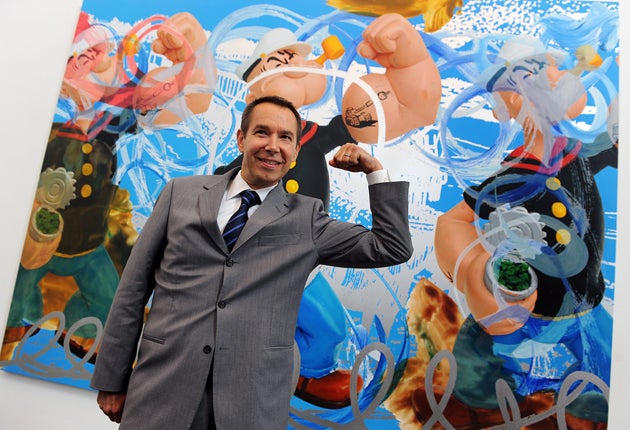Jeff Koons, Serpentine Gallery, London
A surprising note of anxiety underlies Jeff Koons's new show. He should relax: his ability to provoke is strong as ever

Your support helps us to tell the story
From reproductive rights to climate change to Big Tech, The Independent is on the ground when the story is developing. Whether it's investigating the financials of Elon Musk's pro-Trump PAC or producing our latest documentary, 'The A Word', which shines a light on the American women fighting for reproductive rights, we know how important it is to parse out the facts from the messaging.
At such a critical moment in US history, we need reporters on the ground. Your donation allows us to keep sending journalists to speak to both sides of the story.
The Independent is trusted by Americans across the entire political spectrum. And unlike many other quality news outlets, we choose not to lock Americans out of our reporting and analysis with paywalls. We believe quality journalism should be available to everyone, paid for by those who can afford it.
Your support makes all the difference.I'm looking at a splashy, white-framed painting called Moustache Lobsters, its background a scribbled cityscape, its picture plane overlaid with red toy lobsters and a cartoon moustache.
The label says Jeff Koons, although the work – all computerised doodles and saturated colour – looks more like a Gilbert & George. As I stare at it, a slight figure in a suit and tie slips in beside me. I take it for one of the Terrible Twins, but no – the figure is Koons himself, frowning at his work as though surprised to find it here; as if seeing it in the Serpentine Gallery has made him somehow fretful.
None of this is to suggest that Koons shares G&G's taste in art or tailoring, merely that there are moments in this show of his new work when it is easy to mistake the 54-year-old New Yorker for someone else. Moustaches in modern art conjure up Duchamp, who put one on the Mona Lisa. Dali, typically, went one better and gave the picture his own moustache; earlier, he had made a telephone out of a lobster. The cartoon dots in Koons' Popeye (2003) hint at Roy Lichtenstein, while his inflatable turtles and dolphins echo the soft sculptures of Claes Oldenburg. Splashy gestures in the Popeye series look like Abstract Expressionism. Over the whole project hovers the whey-faced shade of Andy Warhol, the man who added kitsch to the high-art ranks of portraiture, still life and history painting; who underlined the off-the-peg nature of his art by calling his studio a Factory; who pissed in our soup and then made us pay, handsomely, to drink it.
All of which is to say that the Koons at the Serpentine Gallery seems more complex than the Koons of old. In part, this is because we tend to see his works singly rather than in groups – the Hanging Heart in the hall of the Palazzo Grassi, say, or the busy-lizzie dog, known locally as el poopy, that guards the door to the Bilbao Guggenheim. To see a number of Koonses together is to see connections between them. Even so, individual works in this show lack the monolithic quality of pieces such as Cracked Egg (Blue) or Rabbit or Michael Jackson and Bubbles – works whose power lay in their simplicity; in asking vast questions about taste and markets and high and low art and then, shiny and amiable, in refusing to answer them.
If Moustache Lobsters is a complex case in point, then so are the more classically Koonsian works in this show. As its name suggests, Dolphin (2003) is the aluminium rendering of a blow-up dolphin, following in a line from inflatables such as Rabbit (1986). But next to Rabbit, Dolphin feels baroque: it is polychrome, and it hangs above one of those suspended pot-racks you find in trendy kitchens. Rabbit's mirrored surface reflected questions back at you – the more you asked of it, the more mute it became. By contrast, Dolphin begs to be read. Its juxtaposition of two unalike things – blow-up toys and saucepans – is like a clue in a cryptic crossword.
A solution that springs to mind is "consumption", the unvarying theme of Koons' art. Whether his subject has been blow-ups or blow jobs, he has always involved us in the act of consuming. His readymades have come from the trashy end of consumerism: cheap plastic toys, pound-store tchotchkes. That is still true, but there are more of them now – to every dolphin its saucepans, each walrus and caterpillar its chair or stepladder. The logs in a metallised kiddy pool, Dogpool, are actually logs. Where Koonses of 20 years ago were wonderfully, cleverly simple, these feel merely clever – as though, given time, we can figure out what the artist meant by juxtaposing moustaches with lobsters, or dolphins with pot racks. And they feel historicist.
I'd say as a result that, while Koons remains a fine artist, his new works lack the dumb majesty of the old. He has always been fascinated by the art market, and maybe it is market forces that have pushed him to change. Or perhaps, at 54, he has decided to court art history by buying it wholesale.
The young Koons once visited Dali in his Manhattan hotel room; in middle age, he has his own Factory in downtown New York. The irony, though, is that he doesn't need Dali or Warhol to make him look great; his own banal genius does that for him.
Join our commenting forum
Join thought-provoking conversations, follow other Independent readers and see their replies
Comments